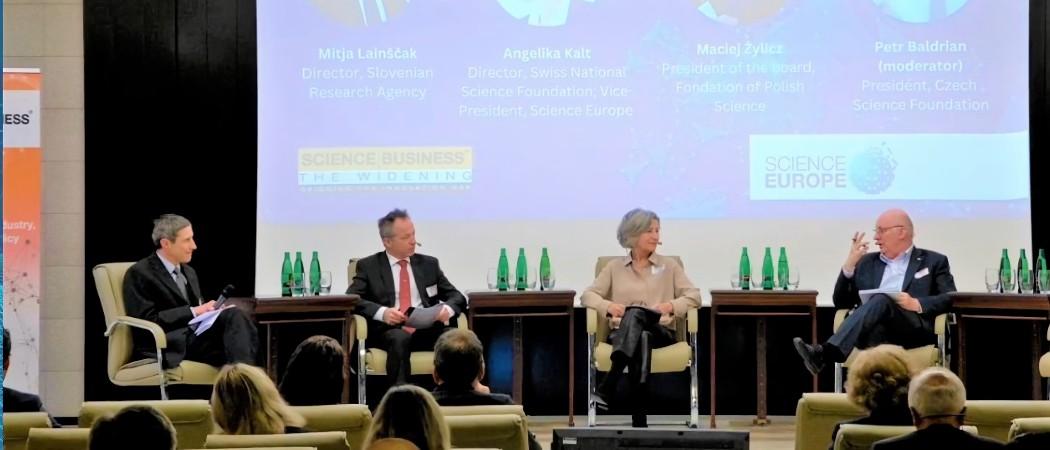New paper prescribes more money for R&I, healthier research culture, more attractive research environments, networking and diversity to tackle brain drain and fragmentation

From left to right: Petr Baldrian, president of the Czech Science Foundation; Mitja Lainščak, director of the Slovenian Research Agency; Angelika Kalt, director of the Swiss National Science Foundation and vice-president of Science Europe; Maciej Żylicz, president of the board for the Foundation for Polish Science
Increasing investments, transforming research culture and boosting talent attraction – these are the recommendations for a more equal European R&I landscape outlined in a new paper by Science Europe.
While talent lies everywhere, not every place in Europe is equally equipped to take advantage of it. This creates uneven talent flows around Europe, creating pockets of excellence in some parts and leaving others without their brightest brains.
Research and innovation capacities differ region by region, and the divide is evident even at country level. This is why policymakers split EU countries into two batches: Widening countries which need to step up their R&I game and non-Widening countries.
The persisting divide has seen many brightest talents from the Widening countries, mostly based in central and eastern Europe, move abroad without looking back. Following EU accession in 2004, 2.2 million people left Poland alone, most headed for western Europe. Of them, 30% held higher education degrees. Few came back and the country struggled to attract talent from abroad, until it started using EU’s structural funds to invest in its R&I ecosystem. It’s paying off: today 50% of postdocs in Poland come from abroad.
Maciej Żylicz, president of the board at the Foundation for Polish Science (FNP), who shared his country’s story during the unveiling of the Science Europe paper last week, said a special programme allowing researchers to open their first lab in Poland had a big impact on attracting talent, with 70% of participants coming from abroad.
And young researchers are clear that a competitive ecosystem is what they need. A recent survey showed that young researchers’ decision to move to Poland rests on three main aspects: a competitive environment, career stability and infrastructure, and salary, in this order of importance. It’s a change of attitude from ten years ago, when a similar survey listed a competitive salary as the top priority, followed by the attractiveness of the research.
Slovenia, meanwhile, is working on nurturing young talent. Looking at rewards from the European Research Council, the EU’s prestigious basic research fund, experienced Slovenian scientists are good at securing grants but younger scientists tend to underperform. “This shows we’re not preparing young people to be competitive,” says Mitja Lainščak, director of Slovenian Research Agency (ARRS).
To tackle the issue, the country now invests in helping its researchers gain experience abroad and runs a special programme that funds 12 projects each year to attract the talent back.
But there’s still room for improvement, and Lainščak hopes the Widening countries can come together to find solutions. “We have the diagnosis and we offered some answers,” said Lainščak. “Maybe the idea should be that EU13 countries should harmonise themselves to have a greater role in the decision making.”
To feed into the debate, Science Europe outlined six key actions member states should take to bridge the gaps in Europe’s fragmented R&I landscape, gathered in a series of workshops this year and presented at a joint conference with Science|Business last week.
“It is not very astonishing that most of these things have been discussed before. We are not going to reinvent the wheel, but perhaps we have a different perspective from what has been said before,” said Angelika Kalt, vice president of Science Europe and director of the Swiss National Science Foundation (SNSF), who presented the paper.
The bottlenecks
It all starts with money. Investments in research and innovation are still not high enough to support excellent. Budgets should be adequate, reliable and paired with clear long-term strategies, in Widening and other countries.
Second, researchers thrive in a healthy research culture. This includes transparent assessment processes, access to training and the ability to explore new ideas. A modern and adaptive research culture is more important than a high salary, the paper notes.
Third, governments should do more to attract and retain talent by creating the right conditions for it. Here, the paper highlights better protection for academic freedom, mobility schemes that help build up networks around Europe, developing top-notch research infrastructures, and ensure they are accessible to all researchers.
Fourth, researchers are only a part of the puzzle. Special attention must be paid to training support staff, such as coordinators, data specialists, research administrators, facilities and funding managers, who are all instrumental in helping get research grants and handling administration.
Fifth, countries should continue to foster networks to boost integration, which enables joint collaborative projects and knowledge exchange. Here, Science Europe envisions a bigger role for COST Actions, an EU programme that facilitates peer-to-peer discussions.
Finally, diversity boosts innovation. To take advantage of it, diversity should be increased among researchers, in terms of ethnic origin, social background, gender, religion, sexual orientation and disabilities, as well as in the research policy itself by providing a more diverse array of research funds and embracing the diversity of research contexts.





 A unique international forum for public research organisations and companies to connect their external engagement with strategic interests around their R&D system.
A unique international forum for public research organisations and companies to connect their external engagement with strategic interests around their R&D system.